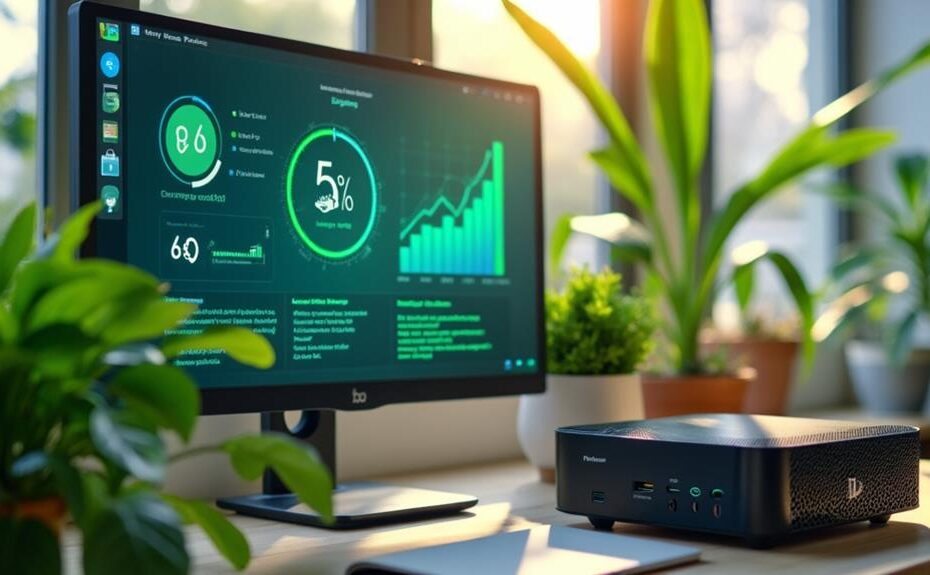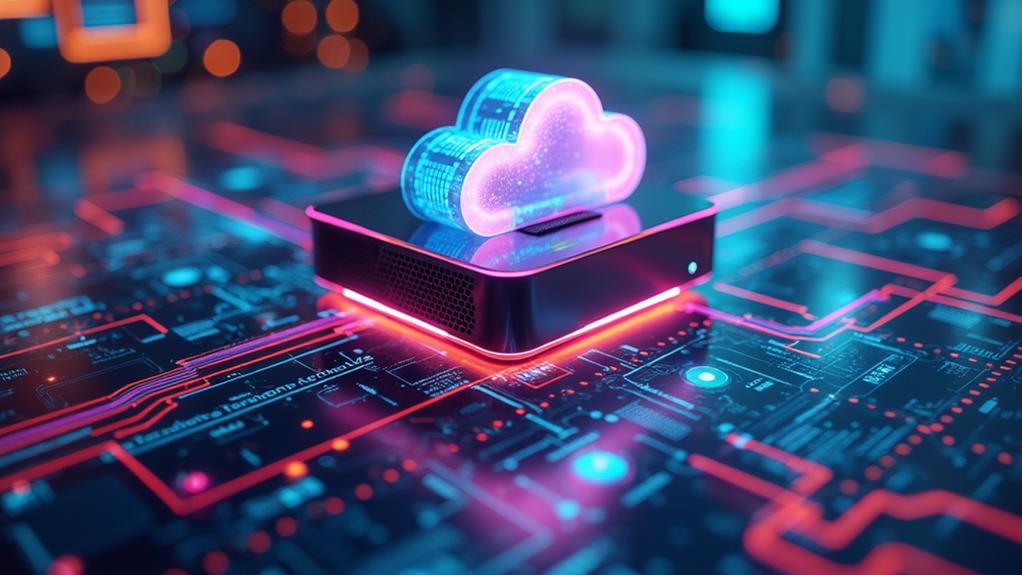



To optimize mini PC performance efficiently, focus on several key protocols. Prioritize energy-efficient hardware, like CPUs with low TDP ratings, ensuring minimal power draw. Implement power management strategies such as CPU throttling, sleep modes, and automated shutdowns during idle periods to save energy. Shift to SSDs for storage, as they consume noticeably less power. Additionally, choose high-efficiency power supplies and use monitoring tools to track consumption. Regular maintenance, including software updates and system cleaning, is essential. By integrating these protocols, you can achieve remarkable energy savings while maximizing performance—more insights await you on further enhancing efficiency.
Key Takeaways
- Prioritize low-power hardware, such as dual-core processors and SSDs, to enhance performance while minimizing energy consumption.
- Implement power management strategies like CPU throttling and automated shutdowns to optimize energy use during idle periods.
- Consolidate storage by transitioning to larger-capacity SSDs, reducing power consumption compared to traditional HDDs.
- Utilize energy monitoring tools to track real-time power usage and identify inefficiencies for targeted adjustments.
- Regularly maintain and update systems to ensure optimal airflow, access energy management features, and improve overall efficiency.
Efficient Hardware Selection
When selecting hardware for mini PCs, it's vital to prioritize efficiency alongside performance. Focusing on power efficiency helps you create systems that run effectively while minimizing energy consumption. Start by choosing the latest desktop CPUs with power-saving features, like Intel's 12th Gen processors, which can consume around 10 watts when idle. Additionally, many mini PCs, such as the Minisforum Mercury EM780, balance performance with low power consumption, achieving maximum load at only 55W. Alternatively, low-power single-board computers, such as Raspberry Pi, can achieve even lower consumption, as little as 6 watts.
Opt for motherboards designed with efficient voltage regulation and robust power management capabilities to maximize energy efficiency. Additionally, selecting dual-core or quad-core processors with low thermal design power (TDP) ratings will help balance performance and energy consumption effectively.
Using energy-efficient components is key; for instance, SSDs consume less power than traditional HDDs, and avoiding unnecessary hardware, like RAID cards, can streamline your setup. By prioritizing these factors in your hardware selection, you're not just optimizing energy but enhancing overall performance in your mini PC. This strategic approach guarantees that every component works cohesively to provide a powerful yet energy-efficient system tailored to your needs.
Power Management Strategies
Implementing effective power management strategies is essential for maximizing the energy efficiency of mini PCs. By employing automated shutdowns, you can considerably cut down energy consumption during idle periods. This feature allows your mini PC to enter a low-power state when not in use, ensuring it only runs when necessary. Mini PCs, equipped with advanced processors and efficient thermal management systems, can optimize performance while minimizing energy consumption during multitasking.
Additionally, utilizing wake-on-LAN technology enables you to power on your mini PC remotely, further optimizing energy savings by keeping it inactive during off-hours. Enabling CPU throttling is another critical strategy; it adjusts the processor's frequency and voltage according to workload demands, effectively reducing power consumption during low usage. You should also activate standby mode for unused drives, which minimizes power draw and conserves energy when devices aren't actively accessed. Regularly reviewing and adjusting your power settings, along with implementing automated scripts to manage power states based on usage patterns, will lead to substantial energy savings.
These power management strategies not only enhance the sustainability of mini PCs but also improve overall system efficiency, allowing you to get the most out of your hardware while minimizing energy waste.
Storage Optimization Techniques
Maximizing energy efficiency in mini PCs extends beyond power management strategies; it also involves optimizing storage solutions. By consolidating your storage with larger-capacity solid-state drives (SSDs) instead of multiple hard disk drives (HDDs), you can greatly reduce power consumption while improving data access speeds. SSDs generally consume only 2-4 watts, compared to 6-10 watts for HDDs, leading to lower idle power usage and enhancing overall energy efficiency. Furthermore, choosing the right storage hardware can further improve both performance and energy savings. Additionally, enabling spin-down mode for unused drives allows them to enter a low-power state when not in use, conserving energy and extending their lifespan. Implementing single storage solutions, such as Network Attached Storage (NAS), minimizes the number of physical drives, effectively reducing both power consumption and maintenance costs.
In addition, avoiding unnecessary hardware like RAID cards streamlines your system architecture, simplifying power management and resulting in lower energy use. With these storage optimization techniques, you can enhance resource utilization in your mini PC, ensuring that every component contributes to reducing power consumption while maintaining performance. Embrace these strategies to achieve a more energy-efficient setup.
Power Supply Efficiency
To achieve ideal energy efficiency in mini PCs, selecting the right power supply is vital. Opt for power supplies with high efficiency ratings, such as those certified by 80 PLUS, which guarantee that at least 80% of the energy drawn from the wall is converted into usable power. This choice can greatly reduce power consumption and minimize energy waste.
Consider using adaptive power supplies that automatically adjust their output based on the system's demands. This feature enhances overall efficiency, particularly during low-demand periods, thereby further reducing unnecessary energy usage. It's essential to match the power supply with your mini PC's specific wattage requirements to avoid overprovisioning, which can lead to excess power consumption.
Utilizing monitoring tools can help you assess your power supply's performance, ensuring the mini PC operates within ideal efficiency ranges. Regularly reviewing and updating your power supply to the latest eco-friendly models will contribute to better energy conservation and lower electricity costs over time. By focusing on these strategies, you can enhance both the energy efficiency and performance of your mini PC, making it a more sustainable choice.
Monitoring Energy Usage
Monitoring energy usage is essential for optimizing the efficiency of mini PCs. By utilizing built-in energy monitoring tools, you can track real-time power consumption, pinpointing which components or applications are consuming the most energy. This data allows you to make informed decisions about necessary hardware upgrades to enhance overall energy efficiency.
Third-party applications can further aid in analyzing energy usage through detailed data analytics. These tools help you optimize settings based on usage patterns, reducing unnecessary energy consumption. Regularly reviewing energy consumption reports can reveal trends and anomalies, enabling you to implement targeted adjustments that improve efficiency.
Additionally, monitoring tools can set alerts for unusual power usage spikes, prompting immediate action to address potential issues before they escalate. Such proactive measures not only safeguard your system but also contribute to an energy-efficient operation.
Maintenance for Efficiency
Regular maintenance of mini PC components is vital for sustaining energy efficiency and performance. Keeping your cooling systems clean and clear from dust not only prevents overheating but also guarantees ideal airflow, enhancing overall performance and reducing energy consumption. Regularly inspect and clean fans and vents to maintain efficient resource usage.
Implement monitoring tools to track energy consumption and performance metrics. These tools identify inefficiencies, allowing you to address issues promptly. Additionally, updating your operating system regularly is important. Doing so grants access to the latest energy management features, which can greatly enhance performance and lower power consumption.
Don't overlook the importance of a robust backup strategy for virtual machines. This minimizes downtime during maintenance, guaranteeing smoother operations. Periodic reviews of power management settings and BIOS configurations are also necessary. Adjust voltage regulation and enable dynamic frequency scaling to improve energy efficiency, making your mini PC more energy-efficient than traditional systems.
Software Impact on Performance
Often overlooked, software plays an essential role in the performance and energy efficiency of mini PCs. By utilizing software designed with energy efficiency in mind, you can greatly reduce energy usage. Advanced operating systems that support features like CPU throttling, sleep, and hibernation modes are essential. These functionalities lower power consumption during inactivity, enhancing overall efficiency.
Efficient coding practices within applications minimize CPU load, which is particularly beneficial for low-power hardware like mini PCs. When your software uses fewer resources, you not only improve performance but also decrease energy demands. Additionally, virtualization software optimizes resource utilization, allowing multiple virtual machines to run without overcommitting resources. This consolidation is key to maximizing energy efficiency while maintaining processing power.
Regular software updates are critical, too. They often bring performance optimizations and bug fixes that guarantee your mini PC runs at its best. These updates help maintain lower energy demands and improve overall system reliability. By prioritizing efficient software choices and staying current with updates, you can make a considerable impact on both performance and energy efficiency in your mini PC setup.
Benefits of Virtualization
When considering energy efficiency in mini PCs, virtualization emerges as a powerful tool. By consolidating multiple virtual machines (VMs) onto a single mini PC, you maximize resource utilization while minimizing the need for additional physical hardware. This greatly enhances energy efficiency, allowing diverse workloads to run on low-power systems, which lowers overall power consumption compared to traditional setups.
Moreover, virtualization offers impressive scalability. You can deploy new VMs quickly and easily, without the physical constraints of additional servers. This flexibility not only optimizes space but also conserves energy, as fewer devices need to be powered and maintained.
The environmental impact is also remarkable; by reducing the number of physical machines, you help decrease electronic waste and resource depletion. Additionally, virtualization leverages hypervisors that provide advanced energy management features. These tools dynamically allocate resources based on demand, optimizing performance while conserving power.
Best Practices for Energy Savings
To achieve ideal energy savings with mini PCs, implementing effective power management strategies is essential. Start by enabling energy-saving features like sleep or hibernation modes during inactivity; this can reduce energy consumption by up to 70%. Shifting from traditional HDDs to solid-state drives (SSDs) is another vital step, as SSDs can lower power usage by approximately 80% while improving data access speeds.
Utilize CPU throttling settings, such as Intel SpeedStep® or AMD Cool'n'Quiet, to dynamically adjust processor performance based on workload. This not only enhances reduced power consumption but also optimizes energy efficiency. Regularly reviewing and adjusting your power management settings can yield significant savings, potentially decreasing power usage by 30% without compromising performance.
Additionally, consider consolidating physical drives by opting for higher-capacity SSDs or HDDs. This strategy minimizes the number of drives required, which helps in minimizing idle power consumption and extends the lifespan of your storage components. By adopting these best practices, you'll effectively balance performance and energy savings, ensuring your mini PC operates at peak efficiency.
Disclosure: As an Amazon Associate, I earn from qualifying purchases.






